Cleaning season has begun onions. The next task of the amateur vegetable grower is to properly prepare the harvested crop and create favorable conditions for its long-term storage. It is important to take into account that the shelf life of the bulbs depends on many factors, and not just on maintaining optimal levels of temperature and humidity in the cellar.
Which onion is best stored? To answer this question, you must first consider the characteristics of each specific variety.
The best varieties of onions for storage
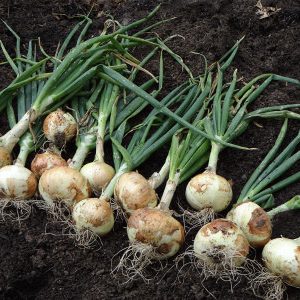 Varieties of onions are usually divided into sharp, semi-sharp and sweet.
Varieties of onions are usually divided into sharp, semi-sharp and sweet.
Spicy onions form a bulb with thick upper scales. Its interior consists of large quantity juicy and loose (up to one millimeter) scales. The bulbs have a distinct pungent taste and are great for both raw consumption and home canning. And thanks to the long period of rest, they are stored almost without loss for 6 to 8 months. The most shelf-stable varieties include Zolotisty, Skvirsky, Strigunovsky Nosovsky. Of course, they are less productive than local zoned varieties, but they are stored just fine.
In plants of semi-sharp varieties, the bulb is looser and has fewer outer scales. They also have few juicy scales, moreover, they are denser (from two to three millimeters) and delicate in taste. Such bulbs are good raw and are not suitable for use in winter preparations. They do not remain dormant for as long as bulbs of sharp varieties and begin to deteriorate already in the beginning of spring. Popular semi-sharp varieties include Lugansky, Karatalsky and Donetsk golden.
Sweet varieties of onions usually have very good yields, but their bulbs are poorly protected by outer scales and consist of a small number of watery scales more than three millimeters thick. Despite the undeniable advantages of such varieties (large size and pleasant taste of the bulbs), they do not last long and begin to sprout soon after harvesting from the garden. For sweet onions, I can recommend the local Yalta onion, it is very unpretentious and very productive.
What else affects the keeping quality of onions?
The quality of storage of onions is also seriously influenced by the timing of planting. In each area, it is necessary to plant seedlings taking into account both weather conditions and the growing season of a particular variety. That is, by the time of harvesting, the onion should have time to ripen properly.
Onions prefer rich, loose soil. However, excess nitrogen fertilizing in the summer slows down its maturation, makes the bulbs less dense and reduces the strength of the upper scales. This, in turn, negatively affects the consumer qualities and keeping quality of the bulbs.
It is also known that it is stored worse than . This happens because the sets may be infected with pathogens that can be transmitted to the resulting bulb.
The duration of storage is also largely influenced by the time of harvesting from the garden. It is advisable to carry out this work during mass lodging of feathers (70-75%), since long-term presence of bulbs in the ground greatly impairs their keeping quality.
Before harvesting for storage, the bulbs must be dried, calibrated and distributed by variety. Then the onions are placed in cardboard or wooden boxes in loose layers and transferred to a dark room with a temperature of 0 to +2 and air humidity of 80-90%. You can find out about other ways to store onions in
Onions are a common vegetable on every table; it’s difficult to do without them, especially in the spring, when last year’s ones are already sprouting and spoiling, and the new harvest is still far away. In this case, you need to know which varieties of onions retain their qualities, both taste and marketability, longer, and grow them on your own plot.
Onion varieties for winter storage.
There are several varieties of onions suitable for storage:
Centurion
Sturon
Stuttgarter Risen
Orion
Centurion bred by Dutch breeders, has good performance germination. The shape of the bulb is slightly elongated, weight is from 90 to 100 g, dense structure, the color of the shell is orange. The ripening period from the emergence of seedlings to maturity is three months. Medium spicy taste, suitable for canning and fresh consumption. It does not bolt in the garden beds, the variety is resistant to diseases, and keeps well in storage.
Sturon also belongs to the Dutch selection, is unpretentious in care, the weight of the bulb can reach 200 grams with proper agricultural technology. The shape of the onion head is similar to an oval, the golden scales have a dense structure with longitudinal stripes, the flesh has a slight greenish tint. The taste is quite spicy with a well-defined onion aroma. Suitable for canning, fresh consumption, and cooking. According to the ripening period, it belongs to the mid-early varieties, 100 – 115 days.
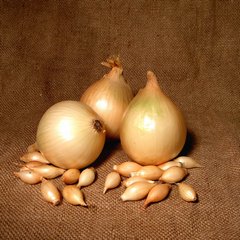 |
|
| Centurion | Sturon |
Stuttgarter Risen– an early variety of German selection, used in the culinary field, in the food industry, for consumption in unprocessed form. The ripening period from seedlings ranges from 95 to 100 days, it is characterized by high yield and resistance to powdery mildew. Doesn't bolt in garden beds, tolerates it well low temperatures. The bulbs are large, reaching a weight of 150 g, flattened in shape, and the color of the cover is golden brown.
Orion- the result of the successful work of English breeders, an improved variety. The bulb is correct round shape weighing about 150 - 200 g, early date ripening, grows well in cold regions, stores well.
 |
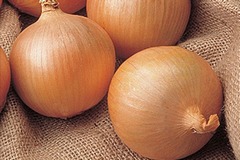 |
| Stuttgarter Risen | Orion |
Varieties of red onions:
Brunswick
Bombay
Red Baron
Carmen
Brunswick refers to multi-cavity early ripening varieties, The best way to get a good harvest - growing in seedlings, the size of the bulbs reaches 6 cm in diameter. It has a flattened shape, with bright purple scales, and is well preserved.
Bombay– mid-season variety, large bulb has a flat shape, dark red scales, good keeping quality.
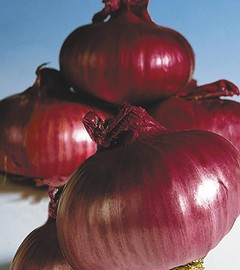 |
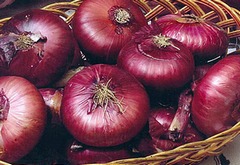 |
| Brunswick | Bombay |
Red Baron– early ripening period, 130 days pass from the appearance of seedlings from the seeding material to harvesting. Bulb small size weighing up to 24 grams.
Carmen– average in terms of ripening period, the period is 120 - 130 days, the bulb weighs from 50 to 71 grams.
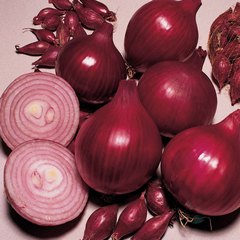
|
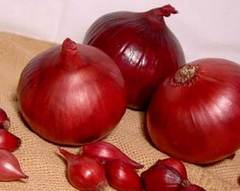
|
| Red Baron | Carmen |
Varieties of large-fruited onions:
Exhibition
Texas yellow
Globo
Exhibition– medium ripening, the bulbs are very large, from 500 to 800 g, the taste is pleasant, without bitterness. Doesn't last long, only a few months.
Globo– a medium salad variety, very large, larger than Exhibition, the weight of one onion reaches 1 kg, round in shape. The taste is juicy and sweet. Grown by seedlings.
Growing onion sets from seeds.
Onion seeds retain good germination only in the first year; later they may not germinate at all. You can check the seed for germination on ten to twenty seeds, and this is how the percentage of suitability is determined. If the seeds are fresh, then before sowing they need to be soaked in warm water with a temperature of +20 +25 0 C for 24 hours, then pickled in the preparation Supervin to protect against root rot. After this, the seeds without liquid must be kept for two days in a room with room temperature+18 +19 0 C, wrapped in a damp cloth.
Before sowing the seeds into the soil, they need to be slightly dried; to do this, you can spread them in a warm, ventilated room in a thin layer on a dry cloth until they become loose and you can start working. Seeds are sown in early spring, as soon as the soil thaws 5-6 cm.
Seed planting scheme.
The rows for planting seeds should be spaced 5 cm apart, with a depth of no more than 2 cm. The gaps between seeds are 1-1.5 cm, this method allows you to obtain onion sets of the same size. Lightly compact the sprinkled crops and water them. To retain moisture in the soil, you need to use a plastic cover; shoots should appear in a week.
You need to water regularly, make sure that weeds do not choke out the thin onion needles, and loosen the soil. Before the onset of hot weather, it will be enough to water once every seven days, in the summer - twice. In July, the ripening phase of the bulb begins, so it is necessary to reduce watering to once every seven days and only on hot days. Timely identify pests and destroy them. You can feed the plants in case of slow development; liquid fertilizer is used; 200 ml of fermented cow or chicken manure and one tablespoon of urea should be diluted in a bucket of water. Nutrient fluid consumption is from 3 to 4 liters per 1 m2.
Harvesting onions and storing them.
Onion harvesting can begin when the feathers turn yellow and almost completely dry, and lodging is observed. Typically, ripening occurs at the end of July - beginning of August, it depends on the ripening period of the variety. The bulbs are pulled out of the ground and laid out to dry for two to three weeks. It is good to dry the vegetable in sunny weather; the feather is cut off from the onion and dried for several more days, preferably with sufficient high temperature air, up to +35 0 C. Dried onions will be stored longer and will not rot.
The next stage is sorting by caliber, at which time you can select small bulbs for winter planting. Larger bulbs are stored in boxes or fabric bags. It is necessary to regularly inspect the seedlings in storage and select spoiled ones so that the resulting rot does not destroy all stocks.
Growing onions using seedlings.
This method is good because you can purchase exactly the type of onion you need, rather than buying a “pig in a poke” on the market, especially since it is much cheaper than growing from sets. But this method is also more labor-intensive; you can fill a cassette with small cells with peat and sow sprouted nigella seeds into each one. When growing on a windowsill, it is necessary to provide additional lighting in the morning and evening. At night you need to place the seedlings in a cool place, and during the day move them to a warm and bright place. Sowing in mid-March simplifies the task of care, daylight hours become longer, and the weather improves.
The sown seeds are sprinkled with a one-cm layer of peat mixture, the soil is compacted, the cassette is covered with polyethylene and a heater is installed. Shoots will appear in a few days; as soon as this happens, the seedlings need to be moved to a bright place.
Watering should be moderate, peat soil contains enough nutrients for the plant, if necessary, you can add complex fertilizer.
Scheme of planting onion seedlings.
Seedlings should be planted according to a 20x30 cm pattern; it is not recommended to add fresh manure to the soil; only humus can be used.
Growing onion from sets.
Planting begins during the warming period. Before planting in open ground, onion sets must be heated at a temperature of +20 0 C for 15 to 20 days, after which the temperature must be increased to no more than +40 0 C, and kept for 9-10 hours. Warming up activates growth processes and will be a good preventive measure against bolting. If long-term heating is not possible, you can use more in a simple way, apply express heating, immerse the planting material in water with a temperature of up to +50 0 C for 10 minutes and then cool with cold water.
Seed planting scheme.
The bulbs are planted at a distance of 10 cm, the row spacing should be 4-5 cm wide, and deepened by 4 cm. Caring for onions consists of periodically loosening the row spacing, removing weeds, watering and fertilizing. During a slow growing season, it is necessary to fertilize with complex fertilizer. Ecoline Vegetable is applied to onion plantings during the bulb formation phase; it can be combined with plant protection products.
Soil preparation.
Onion beds should be located in an open, well-lit place. The best predecessors are tomatoes, potatoes, cabbage, cucumber, and legumes. Onions love loamy soil with the addition of ash, mineral and organic fertilizers. The soil is prepared in advance, in the fall it is dug up with humus and fertilizers per 1 m2:
Superphosphate – 30 g
Ammonium nitrate – 12 g
Potassium salt – 15 g
To disinfect the soil in the spring, the prepared bed can be spilled with a hot solution of 45 0 C copper-containing preparation, 1 tablespoon of copper oxychloride or copper sulfate per 1 bucket of water. Then the soil needs to be covered plastic film and wait for several days.
| < Предыдущая |
|---|
Onions have been known in culinary culture for more than five thousand years. During this time he managed to gain fame for himself healthy vegetable. Phytoncides contained in onions promote a bactericidal effect, which allows the plant to be used in folk medicine as a reliable remedy against ARVI and other inflammatory diseases.
Let's look at the list of onion varieties, noting their advantages and features.
Sweet
Sweet varieties of onions have an excellent taste, ideal for salads. They are high-yielding, and therefore popular in southern regions, which are optimal for the growth of these varieties.
The disadvantage of sweet varieties is that in temperate northern latitudes they are susceptible to disease and produce virtually no harvest.
Spanish 313
This late-ripening onion is widely used in the preparation of salads and consumed fresh due to its rich taste, devoid of bitterness. The bulbs are large, weighing up to 150 grams. Their shape is round, the color is light yellow, the outer scales are not massive, single-layered. The productivity of this variety is considered high.
F1 Comet
The variety is mid-season, but harvesting occurs before the onset of autumn rains. This onion is hardy and unpretentious to growing conditions. The bulbs are widely used for salads; they are juicy, dense in texture and crispy. The variety is good for storage for up to six months and is disease resistant. The variety is characterized by very high productivity.
F1 Malepo
A first generation hybrid characterized by a sweet taste, thanks to which it is used fresh. This variety is large-fruited and high-yielding, not requiring too much care. Prefers southern latitudes, warm dry climate.
Globo
Late-ripening salad onions, which ripen 5 months after germination. In this regard, Globo is often sown as seedlings. The bulbs grow very large, reaching a weight of 700 grams. The shape is flat-round, the outer scales are dry and smooth, single-layered, light yellow. This variety does not last long, but has high yield.
Red Baron
Onions are varieties of Dutch selection. This is a mid-season red salad onion, requiring about three months after germination for the leaves to lode. The bulbs are red, juicy, semi-sharp. The weight of one bulb reaches 170 grams under optimal growth conditions. It has high yields and is very popular due to its taste characteristics and long shelf life.
Centaur
Mid-season onions, characterized by high yield and resistance to diseases and adverse climatic conditions. The variety is often used for winter storage, as onions retain their juiciness for a long time. Due to its sweet, not very spicy and not bitter taste, it is widely used for salads.
Candy F1
The ultra-early hybrid is excellent for salads due to its rich sweet taste. The bulbs, round in shape, reach a weight of 800 grams, which puts the variety in the rank of heavyweights.
The variety is resistant to diseases, but the highest yield is possible only in temperate climate southern latitudes. The scales have a golden color and are formed in one layer. This variety is often compared to Yalta, but Candy is preferred due to its even greater juiciness and softness of taste. Onions are often stored for the winter, as they can be stored for up to six months.
Music F1
Onions are white varieties; they ripen 3-4 months after germination, therefore they are considered medium-late. The oval-shaped bulbs grow up to 130 grams, have a rich aroma and sweet taste with a slight bitterness. The variety is characterized by high yield and ease of care, which is why it is often grown commercially in fields. The bulb has up to three dry scales white. Suitable for a short period of storage; storing it for the winter is not recommended.
Acute
Spicy onions are characterized by early ripening and high yield. In addition, it is subject to long-term storage, which is why it is suitable for winter preparations. Spicy varieties have a high concentration of dry matter and essential oils. It is often grown in fields due to the presence of several dense balls of scales that protect the bulbs from mechanical damage from agricultural machinery.
Chalcedony
The variety is mid-season, the optimal growing width is southern lands. The safety of onions during the winter period is up to 98%, which makes it increasingly popular.
High yield is accompanied by an average size of bulbs, which reach a weight of 140 grams. The bulbs are medium-sharp, juicy, their scales are golden-brown in color.
Aleko
A mid-season onion, a notable feature of which is that it does not cause tears when cut. It tastes sweet with a hint of bitterness, quite spicy, but goes well with vegetables in a salad. Reaches a weight of 120 grams under favorable conditions.
The bulbs are oblong in shape, dense in structure, rich in vitamins and other beneficial substances due to their high dry matter content.
Arzamas local
A domestic variety bred for the Nizhny Novgorod region. The onions are mid-season, the turnips are small, weighing about 40-80 grams. The variety has a long shelf life in winter. The bulbs have a shape from round to oblong. The outer scales are dark, with a bronze tint, the inner ones are white and juicy.
Bessonovsky local
Onions bred in the Penza region are early ripening. The turnip is round-flat in shape and dense in structure. The outer scales are dry, yellow, the inner scales are juicy and white. The bulbs are small in size, weigh up to 45 grams, and taste quite sharp and bitter. Their advantage is good shelf life in winter. Used for both salads and preserves.
Strigunovsky local
Early ripening onions, distinguished by their ability to be well preserved during storage, have a pleasant pungent taste, rich onion aroma and a large amount of phytoncides. Dry scales are painted yellow, juicy - white. This variety is usually harvested for the winter and used in various culinary dishes fresh and dried.
Timiryazevsky
This early-ripening onion variety has small turnips weighing 50-70 grams. The shape of the bulbs is flat-rounded, the color of the upper scales is brownish-yellow, sometimes lighter. They taste sharp and bitter. Possesses high level keeping quality. Well tolerated unfavourable conditions, due to which it is grown in the Urals and Siberia.
Stuttgartenriesen
Large bulbs of this variety have a rich, not too spicy taste. The weight of turnips, flat-round in shape, reaches 250 grams. This is a variety of German selection, which is characterized by high productivity. It is very popular among mid-season varieties due to its versatility due to its mild taste.
Ufa local
The birthplace of this old variety is Ufa. It is characterized by cold resistance and medium shelf life. The size of the bulbs is also average, they are round or slightly elongated in shape. The unpretentiousness of this onion makes it popular in almost all climatic zones.
Siberia F1
An early ripening variety of onions is suitable for winter storage. Like all Siberian varieties, they are unpretentious in care and maintenance. weather conditions. A medium-sized bulb weighing 100 grams has a broadly elliptical shape. There are 3-4 outer scales; they are yellow with a brown tint. Juicy white scales.
Peninsular
Peninsular varieties are distinguished by a small amount of external dry scales. The bulbs are not very dense, which adversely affects harvesting by agricultural machinery. Basically, the storage of such varieties has average duration. They are more productive than others, but they take quite a long time to ripen.
Danilovsky 301
The mid-season variety produces bulbs weighing from 80 to 160 grams. This is a red variety of onion, the outer scales of which are purple or red with a purple tint. The bulb is flat or more round in shape. The juicy part of the bulb is also light purple in color. This onion tastes semi-sharp and soft, which is why it is actively used in salads. The productivity of the variety is high.
Zolotnichok
A mid-early variety with rounded bulbs of light yellow color with a golden tint. The taste is semi-sharp, medium in size, weighing up to 100 grams. The variety preserves well in winter. The semi-sharp taste allows this onion to be used for a wide variety of purposes.
Carmen
The red onion variety has high yield and long-term storage. This is a variety of Dutch selection, ripens in less than three months after germination. The bulbs are small, weighing 60-80 grams. Their shape is round, flattened, the structure is not very dense. The taste of this onion is sweet despite its spiciness. It has high bactericidal properties due to the concentration of dry matter in the bulb.
Albion F1
The variety is mid-season, hybrid, with medium-sized bulbs of a rounded shape, reminiscent of a droplet. The color of the bulb is white, the structure is dense, the surface is smooth. The shelf life after harvest is until the end of December. Suitable for canning and drying due to high dry matter content.
Spirit F1
The first generation hybrid is characterized by early fruiting. The bulb has yellow With brown tint. The variety has a high level of keeping quality in winter. Thanks to the harmonious combination of pungency and sweet taste, it is used for various purposes in cooking. Turnips are beautiful to look at, which makes them popular for commercial cultivation.
shallot
The peculiarity of shallots is their mild taste, close to sweet onions, and the nesting type of bulb formation.
Kuban yellow
The mid-season semi-sharp variety has small round bulbs weighing 30 grams. There are 3-4 turnips in one nest. The color of the outer dry scales is yellow with a brown tint, the inner juicy ones are white, sometimes with a green tint. This variety tolerates dry weather well and does not need watering all season. Its homeland is the Lower Volga region of Russia, where it grows best.
Star
This variety is early ripening: suitable for digging two months after germination. Pungent in taste, high-yielding at good care. The bulbs are small in size, oval in shape. The color is white or with a yellow tint. Popular both for fresh use and for canning or drying.
Russian purple
An early-ripening, high-yielding variety of shallots has purple upper scales. The nest contains up to 20 small bulbs of a round, slightly flattened shape. Good keeping quality makes the variety popular among experienced gardeners.
Siberian yellow
The small bulbs of this mid-season variety have a high shelf life in winter. The turnips are yellow, flat, very small: from 8 to 20 grams. The variety is resistant to diseases and bad weather conditions. Tolerates drought and cold summers well.
Bonilla
The variety is resistant to cold and even frost, which makes it popular in the northern latitudes of Russia. It is distinguished by its ability to give birth equally well in one place for up to 5 years in a row, which is interesting for summer residents with small plots of land.
The bulbs are small but juicy. In addition to turnips, the soft greens of this onion are actively used in cooking. Which can be cut up to three times per season.
Arzamas local is a very spicy mid-season variety of onions. The growing season is about 3 months. The shape of the bulbs is round or slightly elongated, the scales are juicy and dense. The weight of a ripe onion can reach 70 g. It has good keeping quality.
Bessonovsky local- a pungent early-ripening variety. The bulbs are white, medium-sized, slightly flattened, the scales are yellowish, dense. One “nest” usually contains 4 onions, each of which weighs no more than 40 g. The onion is not resistant to infectious diseases. Designed for long-term storage.
Odinovets- a sharp variety, unpretentious to growing conditions. The growing season is about 3.5 months. The bulbs are slightly flattened, with a golden-white shell and very juicy white scales.
Rostov local onion- a spicy, early-ripening variety of onions. The bulbs are almost spherical, yellowish, and can be stored for a long time.
Strigunovsky local- early ripening, very spicy variety. The bulbs are slightly elongated from top to bottom, the scales are juicy. One “nest” usually develops from 2 to 3 bulbs weighing about 75 g each. This variety of onion is not resistant to common infectious and fungal diseases, but can be stored for a long time without losing its valuable taste.
Timiryazevsky- a spicy, early-ripening variety of onions with a growing season of 2.5 to 3 months. The bulbs are large, almost spherical in shape, with dense juicy scales. Most often grown for subsequent long-term storage.

Semi-sharp varieties of onions, unlike hot ones, are used not only for pickling vegetables and cooking hot sauces, but also for salads, fresh savory appetizers. Most popular in middle lane Russia uses varieties Kaba, Karatalsky, Krasnodar G-35.
Remember useful tips O planting onion sets. Just the necessary knowledge about how to plant onions.
Kaba- a late-ripening variety, not very spicy, with a characteristic yellow color of the bulbs. The growing season is about 4 months. The bulbs are slightly flattened, dense, massive. Plants are easily infected with downy mildew and affected by onion flies. This variety is not suitable for winter storage.
Karatalsky- a common semi-sharp variety. The bulbs are round or almost flat, with dense, juicy scales, weighing about 100 g. Adult plants often develop neck rot or downy mildew. Ripe onions can be stored for 3-4 months in well-ventilated cool areas.
Krasnodar G-35- mid-season semi-sharp variety of onions. The growing season is from 3 to 4 months. The upper scales of the bulb are white, round or oval in shape, weight reaches 110 g. The internal juicy scales are yellowish or pinkish. Not used for storage.
Low-spicy onion varieties
Low-spicy varieties are also called salad varieties. The juice of such onions has almost no natural acrid bitterness, so the plants can be used fresh for preparing snacks, salads, summer sandwiches and canapés. The most popular varieties from this group are Danilovsky 301 and Orange.
Danilovsky 301- mid-season, practically not spicy variety. The bulbs are round, slightly flattened. The husk is a juicy purple hue. This variety of onion is not resistant to downy mildew. Not used for long-term storage.
Orange- sweet salad variety. The bulbs are round, very dense, weighing up to 110 g. The husk is orange or bright yellow. Ripe onions keep well in the cold.
Choosing soil for planting onions
For cultivating all of the listed onion varieties, soil with a light mechanical structure and a high content of humic compounds is suitable. It is advisable to use potatoes and early ripe cucumbers as predecessor plants.
The vegetable grows poorly on heavy soils. As a top dressing in the fall, rotted manure or compost, as well as high-moor peat, are added to future ridges. You can also add complex mineral fertilizers to the soil, observing the proportions indicated on the package. Having distributed the nutrient mixtures evenly over the area, the substrate should be dug up and harrowed again. After planting onions, organic compounds are not added, otherwise the yield of the vegetable crop will decrease significantly - the bulbs will turn out small due to the increase in the mass of green feathers.
Usually, for planting in open ground, they choose the so-called onion sets with a bulb diameter of about 2 cm. Planting material of a more impressive size will produce many green arrows. Before planting in ridges, seedlings must be warmed up at a temperature of about 35° C for 1-2 weeks.
Preparing seedlings before planting
A few days before planting, the bulbs should be germinated by placing them under a layer of clean burlap and periodically watering them with heated water. For planting, shallow grooves are prepared, the distance between which should be at least 20 cm.
If onions are grown from seeds, sowing is done in late August - early September, the bulbs are immersed in the soil in April-May. Early ripening varieties produce the first abundant harvest by the end of June.
Fertilizing before planting In order for the onion to grow and develop well, 2 weeks after planting, mineral fertilizer is added to the substrate, while thinning out too thick seedlings. Fertilizers should not contain nitrates, since nitrogen compounds can accumulate in the juicy scales of the bulbs. Watering should be frequent, at least once a week, but not too much.
Harvesting begins after the leaves droop. Ripe bulbs are carefully removed from the previously loosened soil and, without cutting off the drying tops, laid out on the beds to dry. When the leaves noticeably dry out and the neck becomes thinner, the onion can be stored for storage by cutting off the tops and roots. The vegetable is best preserved in nets or braids if the room is well ventilated.

